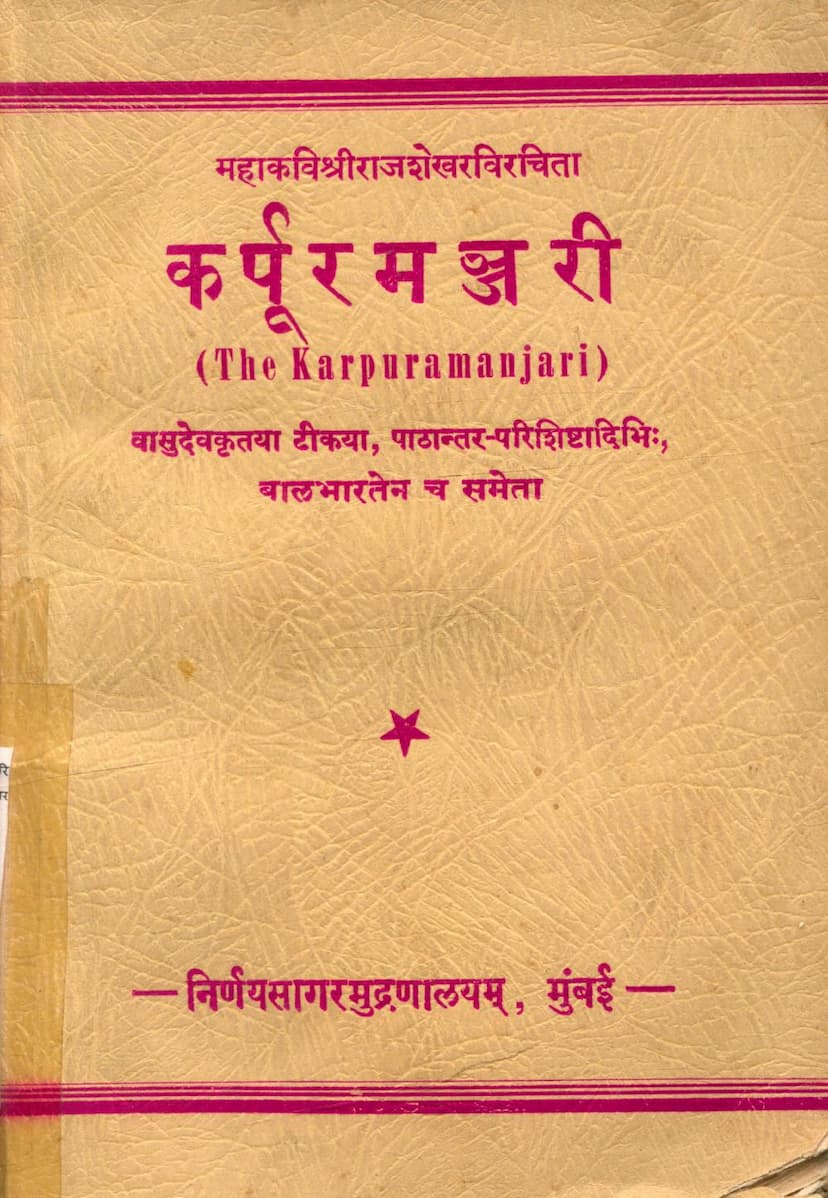Karpur Manjari
Added to library: September 2, 2025

Summary
This document is the preface and the first act of the Sanskrit play "Karpuramanjari" (The Jasmine of Camphor) by the renowned poet Rajashekhar. The text also includes the commentary by Vasudeva.
Here's a breakdown of the key information:
Book Details:
- Title: Karpuramanjari (कर्पूरमञ्जरी)
- Author: Rajashekhar Mahakavi (महाकविश्रीराजशेखर)
- Publisher: Nirnaysagar Mudranalay (निर्णयसागरमुद्रणालय), Mumbai
- Edition: Fourth Edition (चतुर्थ संस्करणम्), 1949
- Price: 2.50 Rupees
- Commentary: By Vasudeva (वासुदेवकृतया टीकया)
- Additional Content: Includes variant readings (पाठान्तर) and appendix (परिशिष्टादिभिः), and also the Balabharata (बालभारतेन).
Preface (Pages 4-18):
The preface provides a detailed scholarly introduction to Rajashekhar and his works, focusing on establishing his historical context and literary contributions.
- Rajashekhar's Time Period: The preface discusses various scholarly opinions on when Rajashekhar lived, referencing different texts like Shankara Vijaya, Bhoja's Sarasvatikanthabharana, Kshemendra's works, and Wilson's "Hindu Theatre." It points out the difficulties in definitively dating him, but suggests he likely lived between 884 CE and 959 CE, citing his contemporary poets Anandavardhana and Ratnakara as mentioned in his works.
- Lineage and Origin: It explores the debate about whether Rajashekhar was a Brahmin or Kshatriya, noting his use of terms like "Upadhyaya" and "Guru," which point towards Brahminical association. However, it also mentions his wife belonging to the Chauhan (Chahamana) clan, a Kshatriya lineage, leading to speculation about his own caste or marital context. The text also discusses his possible origins from Maharashtra or Chedi.
- Known Works: The preface lists four main works attributed to Rajashekhar: Balaramayana, Balabharata (also known as Prachandapadava), Karpuramanjari, and Viddhasalabhunjika. It notes that only the introductions to Balabharata and Balabharata itself are partially available.
- Literary References: The preface highlights how Rajashekhar's works reference many other poets like Bhartri-mentha, Bhavabhuti, Kalidasa, Bana, Shudraka, and others. It also mentions that Rajashekhar's verses are quoted in other later works like Dasharupaavaloka, Sarasvatikanthabharana, and Abhinavagupta's Locana.
- Karpuramanjari's Genre: It identifies Karpuramanjari as a "Sattaka" (सट्टक), a dramatic form primarily in Prakrit, with specific characteristics like a large number of characters, absence of Viskhambhaka (transitional act), and the use of various Rasas.
- Linguistic Analysis: The preface delves into the linguistic aspects of the Karpuramanjari, discussing the use of Prakrit, different poetic styles (Vaidarbhi, Magadhi, Panchali), and figures of speech.
First Act (Pages 18-61):
This section details the beginning of the play, including the prologue (Javanikantara or Prastavana).
- Nandi: The play begins with a Nandi (नान्दी), a benedictory verse recited by the Sutradhara (सूत्रधार - the stage manager) invoking Saraswati, other poets, and wishing well for the play. The Nandi itself is analyzed for its poetic qualities and meaning.
- Sutradhara's Role: The Sutradhara introduces the play, describes the preparations for the performance, and mentions the playwright Rajashekhar.
- Introduction of the Play's Nature: The play is identified as a Sattaka. The dialogue between the Sutradhara and Pariparsvika (पारिपार्श्वक - an attendant) reveals that the play is about the courtship and marriage of the protagonist.
- Characters Introduced: The King (Raja), Queen (Devi), Vidushaka (विदूषक - the jester), and various attendants are introduced.
- Thematic Elements: The initial dialogue highlights the joy of spring (Vasanthotsava) and the King's admiration for the heroine. It also introduces a comical rivalry between the Vidushaka and a female character, Vichakshana, who is a poetess.
- The Heroine's Introduction: The heroine, Karpuramanjari, is brought onto the stage, captivating everyone with her beauty and grace.
- The Plot Setup: The initial scenes establish the context for the unfolding romantic plot and the playful interactions between the characters. The play seems to be set in a royal court during spring.
- Subsequent Acts (mentioned but not detailed here): The provided text only covers the preface and the first act. The subsequent acts are only indicated by the continuation of the play's title.
In essence, this document provides a scholarly foundation for understanding Rajashekhar's Karpuramanjari, establishing its historical context, literary significance, and the initial dramatic setup of the play.